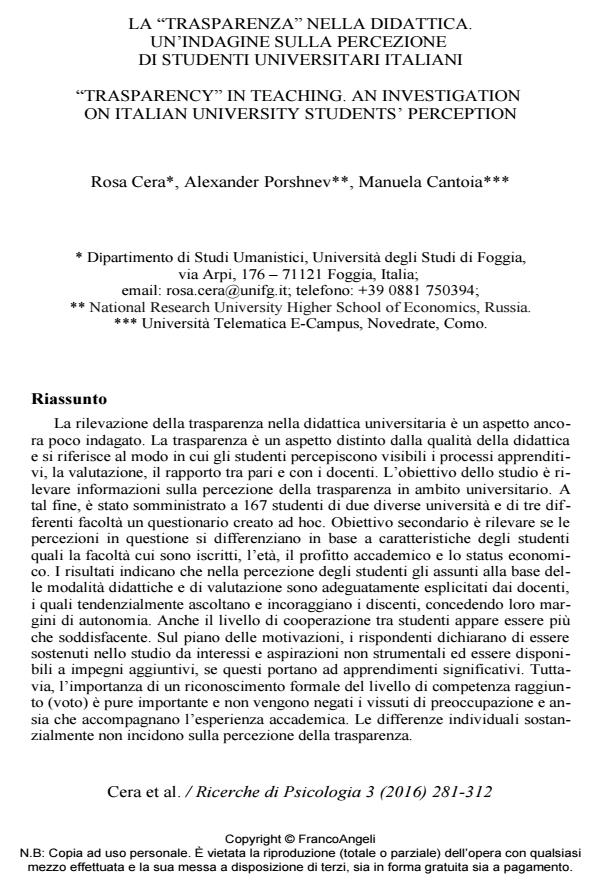La "trasparenza" nella didattica. Un’indagine sulla percezione di studenti universitari italiani
Titolo Rivista RICERCHE DI PSICOLOGIA
Autori/Curatori Rosa Cera, Alexander Porshnev, Manuela Cantoia
Anno di pubblicazione 2016 Fascicolo 2016/3
Lingua Italiano Numero pagine 32 P. 281-312 Dimensione file 282 KB
DOI 10.3280/RIP2016-003002
Il DOI è il codice a barre della proprietà intellettuale: per saperne di più
clicca qui
Qui sotto puoi vedere in anteprima la prima pagina di questo articolo.
Se questo articolo ti interessa, lo puoi acquistare (e scaricare in formato pdf) seguendo le facili indicazioni per acquistare il download credit. Acquista Download Credits per scaricare questo Articolo in formato PDF

FrancoAngeli è membro della Publishers International Linking Association, Inc (PILA)associazione indipendente e non profit per facilitare (attraverso i servizi tecnologici implementati da CrossRef.org) l’accesso degli studiosi ai contenuti digitali nelle pubblicazioni professionali e scientifiche
La rilevazione della trasparenza nella didattica universitaria e un aspetto ancora poco indagato. La trasparenza e un aspetto distinto dalla qualita della didattica e si riferisce al modo in cui gli studenti percepiscono visibili i processi apprenditivi, la valutazione, il rapporto tra pari e con i docenti. L’obiettivo dello studio e rilevare informazioni sulla percezione della trasparenza in ambito universitario. A tal fine, e stato somministrato a 167 studenti di due diverse universita e di tre differenti facolta un questionario creato ad hoc. Obiettivo secondario e rilevare se le percezioni in questione si differenziano in base a caratteristiche degli studenti quali la facolta cui sono iscritti, l’eta, il profitto accademico e lo status economico. I risultati indicano che nella percezione degli studenti gli assunti alla base delle modalita didattiche e di valutazione sono adeguatamente esplicitati dai docenti, i quali tendenzialmente ascoltano e incoraggiano i discenti, concedendo loro margini di autonomia. Anche il livello di cooperazione tra studenti appare essere piu che soddisfacente. Sul piano delle motivazioni, i rispondenti dichiarano di essere sostenuti nello studio da interessi e aspirazioni non strumentali ed essere disponibili a impegni aggiuntivi, se questi portano ad apprendimenti significativi. Tuttavia, l’importanza di un riconoscimento formale del livello di competenza raggiunto (voto) e pure importante e non vengono negati i vissuti di preoccupazione e ansia che accompagnano l’esperienza accademica. Le differenze individuali sostanzialmente non incidono sulla percezione della trasparenza.
Parole chiave:Trasparenza, didattica universitaria, rapporto studenti-docenti; apprendimento collaborativo, apprendimento auto-regolato, motivazione.
Rosa Cera, Alexander Porshnev, Manuela Cantoia, La "trasparenza" nella didattica. Un’indagine sulla percezione di studenti universitari italiani in "RICERCHE DI PSICOLOGIA " 3/2016, pp 281-312, DOI: 10.3280/RIP2016-003002